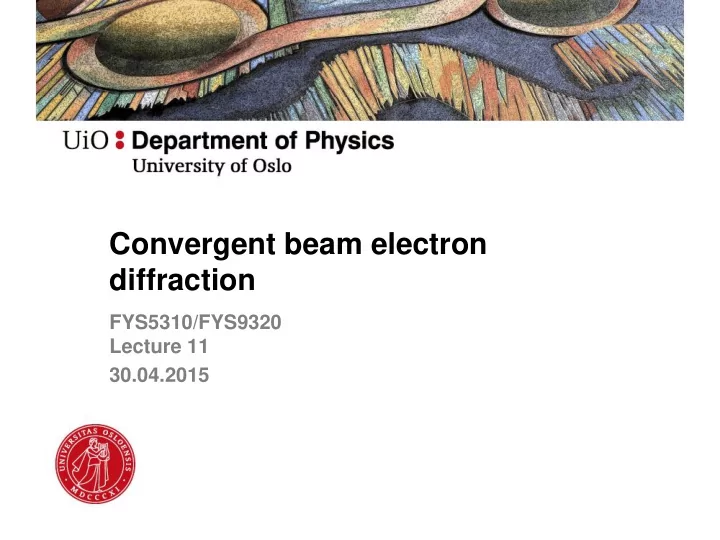

Convergent beam electron diffraction FYS5310/FYS9320 Lecture 11 30.04.2015
Uses of CBED • Symmetry determination • Measurement of thickness • Determination of structure factors 2
3
The structure factor Incoming wave: 2 i k r ( k , r ) Ae 0 0 k B k ' Wave scattered from atom j in : r k B 2 i k r 2 i k ' ( r r ) 2 i ( k r k ' r k ' r ) ( r ) f e e f e A A A A A A A A 2 i k r 2 i k ' r k ' f e e A r A A Equivalent expression for atom B Origin Total scattered wave detected far away: 2 i k r 2 i k ' r 2 i k r 2 i k ' r ' ( r ) ( r ) ( r ) f e e f e e A B A B A B 2 i k r 2 i k r 2 i k ' r { f e f e } e A B A B 2 i k r Can be calculated for all scattering vectors (angles) Δ k , but usually F f e j we only concern ourselves with Δ k = g (destructive interference in all j k other cases) j
The structure factor In (parallell beam) electron diffraction, we very often concern ourselves only with: – Position of peaks – Systematic absences These are the «structure parts» of the structure factor. We can also look at the peak intensities, commonly done in XRD, to determine site occupancies 2 i k r j F f e j k j 6
What about f ? • f is the atomic form factor, also called the atomic scattering factor. • Usually expressed as a function of scattering angle s f(s) sin 𝜄 • 𝑡 = 𝜇 7
The atomic form factor for X-rays • The electron cloud has a shape and size • Different sub-volumes of the electron cloud scatter at different strengths • The atomic scattering strength is the sum of all of these sub- volumes. The Fourier-transform of the electron density
… and electrons The Mott formula
X-ray scattering factors 30.00 25.00 20.00 Co f(s) [1/e] 15.00 Fe Mn Cr V 10.00 5.00 0.00 0.00 0.20 0.40 0.60 0.80 1.00 1.20 1.40 1.60 1.80 2.00 s
• When the atoms participate in a solid, bonds are formed between them. • A reduction in total energy is achieved by re- arranging the electrons • This causes a change in the form factors • And thereby the structure factors • Example Fe FeO or Fe2O3
X-ray scattering factors 30.00 25.00 20.00 Co Fe f(s) [1/e] Mn 15.00 Cr V Fe2+ 10.00 Fe3+ 5.00 0.00 0.00 0.20 0.40 0.60 0.80 1.00 1.20 1.40 1.60 1.80 2.00 s
• The effects of bonding are most prominent at small scattering angles • In which compounds do you think the effect is largest? • Both X-ray and electron diffraction can be used to study this • But which one do you think is most sensitive to charge redistribution?
Magnesium diboride • Hexagonal structure • Superconductivity discovered in 2001
CBED on MgB 2 Experiment Calculated from procrystal Best fit to experiment
Procrystal: no atomic interaction (bonding)
Conclusion • Convergent beam electron diffraction can be used to measure stucture factors – and more specifically: changes in scattering amplitude due to bond formation • It is particularly well suited to low index structurefactors (reflections) • These are the reflections that are most sensitive to bonding
Recommend
More recommend